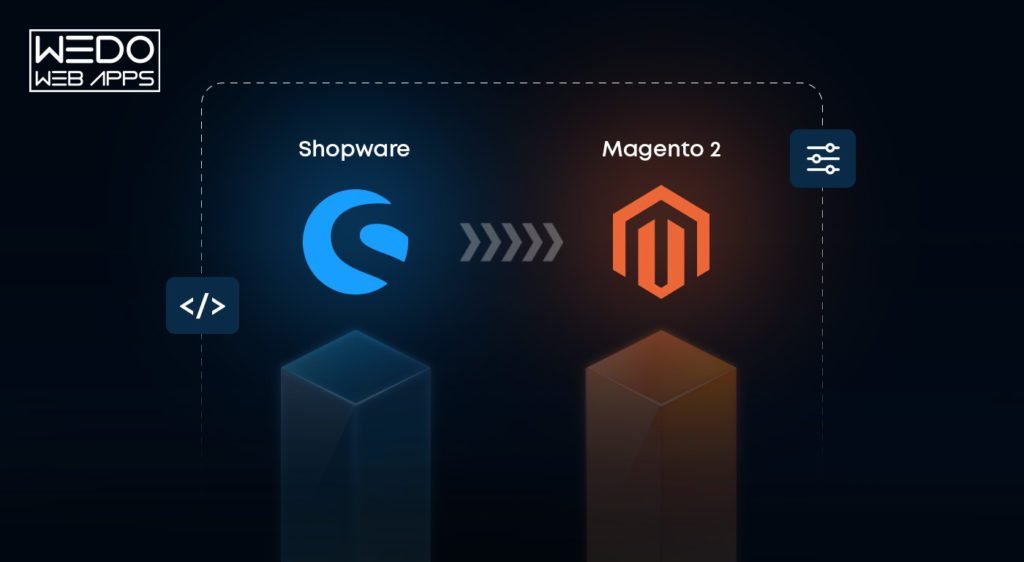14 Mar, 2023 | Magento development
Shopware to Magento 2 Migration

Understanding Shopware and Magento 2
When choosing an e-commerce platform, businesses often consider the features, scalability, and support that each platform offers. Shopware and Magento 2 are the most popular e-commerce platforms with features and benefits.Overview of Shopware and its features:
Shopware is a German e-commerce platform that was first released in 2000. Today, it has tons of installations worldwide. It is known for its intuitive and user-friendly interface, making it a good choice for businesses that want to quickly set up an online store without needing a lot of technical expertise.Shopware offers a range of features, including:
-
Customizable templates and themes:
-
SEO optimization tools:
-
Multi-language and multi-currency support:
-
Marketing and promotional tools:
Overview of Magento 2 and Its Features:
Magento 2 is an open-source e-commerce platform that was first released in 2015. Its advanced features and customization options have become a favorite among developers and businesses of all sizes.For making a magento store offers a range of features, including:
-
Advanced product management and inventory tracking:
-
Customizable templates and themes:
-
SEO optimization tools:

-
Payment and shipping options:
-
Multi-language and multi-currency support:
-
Scalability and performance optimization:
Comparison of Shopware and Magento 2:
While both Shopware and Magento 2 offer a range of features and benefits, there are some key differences between the two platforms that businesses should consider when choosing an e-commerce platform and hiring experts for Magento 1 to Magento 2 migration services.-
Ease of use:
-
Customization:
-
Pricing:
Reasons for Migrating from Shopware to Magento 2
Shopware and Magento 2 are two popular eCommerce platforms that offer various features and functionalities to online businesses. While Shopware is known for its user-friendly interface and ease of use, Magento 2 is preferred for its scalability and flexibility. In this section, we will discuss the reasons for migrating from Shopware to Magento 2, including the limitations you may face having a shopware store, the advantages of Magento 2, and a cost comparison between the two platforms.Limitations of Shopware
-
Limited Scalability:
-
Limited Extensions:
-
Less Support:
-
Steep Learning Curve:
Advantages of Magento 2
-
Scalability:
-
Extensive Extensions:
-
Large Community:
-
Flexibility:
Cost Comparison between Shopware and Magento 2
The cost of migrating from Shopware to Magento 2 depends on several factors, including the size and complexity of the online store. However, in general, Magento 2 may be more expensive than Shopware.-
License and Subscription Fees
- Shopware offers both free and paid licenses.
- Magento 2 also offers a free license, but the Enterprise Edition can cost up to $22,000 per year for larger businesses.
-
Hosting Costs
- Shopware and Magento 2 require hosting, with the cost varying depending on the hosting provider and the hosting package chosen.
- Magento 2 has a reputation for requiring more server resources and higher hosting costs due to its complex architecture, while Shopware is generally less resource-intensive.
-
Development and Design Costs
- Migrating from Shopware to Magento 2 requires significant development work, including data migration, theme customization, and module development.
- Magento 2 has a steeper learning curve, which can result in longer development times and higher development costs compared to Shopware.
-
Third-Party Integrations and Add-ons
- Shopware and Magento 2 have a large community of developers and third-party providers offering various integrations and add-ons.
- However, some third-party integrations may be more expensive for Magento 2 due to the complexity of the platform.
-
Maintenance and Support Costs
- Shopware and Magento 2 require ongoing maintenance and support to ensure optimal performance and security.
- Magento 2 may require more frequent updates and patches due to its complexity, which can result in higher maintenance costs.
-
Training Costs
- If you are migrating from Shopware to Magento 2, you may need to provide training for your team on how to use the new platform.
- Magento 2's steeper learning curve may require more extensive training, resulting in higher costs than Shopware.
Planning the Migration
Migrating from Shopware to Magento 2 can be a daunting task that requires careful planning to ensure a smooth transition. Shopware and Magento 2 are robust ecommerce platforms with different functionalities, features, and limitations. Therefore, it's crucial to plan carefully to minimize disruptions to your business operations, ensure that your new platform meets your business requirements and objectives, and identify potential risks and challenges that may arise during the shopware migration process.Importance of Planning
Migrating from one ecommerce platform to another can be a complex process that requires careful planning. Proper planning ensures the migration process is smooth, efficient, and successful. Planning can help you:- Identify potential risks and challenges and plan accordingly
- Determine the resources required for the migration, such as time, budget, and personnel
- Minimize disruptions to your business operations while migrating
- Ensure that your new ecommerce platform meets your business requirements and objectives
Steps Involved in Planning the Migration
Here are the key steps involved in planning the migration wizard from Shopware to Magento 2:-
Analyze your current ecommerce platform
- Assess your current ecommerce platform's functionality, features, and limitations
- Identify areas for improvement or customization in your new platform
-
Define your business requirements and objectives.
- Determine your business objectives for migrating to Magento 2
- Identify the key features and functionality you need in your new ecommerce platform
-
Choose a migration method.
- Decide whether to perform the migration yourself or hire a professional service.
- Select a migration tool that supports Shopware to Magento 2 migration.
-
Plan for data migration
- Identify the data you need to migrate, such as customer, order status, product, and shipping.
- Ensure that your new platform is compatible with your data format and structure.
- Develop a data migration plan, including mapping, cleansing, and validation.
-
Plan for customization and development
- Identify areas that require customization, such as themes, extensions, and integrations.
- Plan for the development of custom features, modules, and extensions
- Ensure that your new platform can handle your customizations and integrations
-
Plan for testing and training
- Develop a testing plan to ensure that your new platform functions as expected.
- Plan for user training to ensure that your team can effectively use the new platform
Data Migration Process
Data migration is a critical part of the migration process. Here are the key steps involved in data migration:-
Extract data from your current ecommerce platform
- Extract data from your Shopware platform using a migration tool
- Ensure that the data is in a compatible format for Magento 2
-
Map and transform data
- Map your data from Shopware to Magento 2 data structures
- Transform and cleanse the data as needed
-
Load data into Magento 2
- Load your data into Magento 2 using a migration tool
- Validate the magento data to ensure that it has been successfully migrated
-
Verify and test data.
- Verify that your migrated data is accurate and complete
- Test your data to ensure that it functions as expected in Magento 2

Post-Migration Testing
After the migration process, it's essential to perform post-migration testing to ensure the new site functions correctly. Here are some key aspects of post-migration testing:Importance of Post-Migration Testing
Here are some important points describing the importance of Post-migration testing:- Ensures that the new site meets all the functional requirements and objectives
- Helps to identify any bugs, errors, or performance issues that may have occurred during the migration process
- Minimizes the risk of site downtime and loss of revenue
- Helps to ensure that the customer experience is not impacted negatively
Types of Testing to Perform
-
Functional Testing:
-
User Acceptance Testing:
-
Performance Testing:
-
Security Testing:
Resolving Issues that Arise During Testing
While testing, it's possible that some issues might arise. Here are some points that can help you deal with and resolve the issues that arise:- Document and prioritize all issues that arise during testing
- Work with your migration assistant development team to identify the root causes of any issues
- Develop and implement a plan to address and resolve all identified issues before launching the new site
Launching the New Site
After successful testing, it's time to launch the new site. Here are some key aspects of launching the new site:Importance of Launching the New Site
- Minimizes disruptions to your business operations
- Ensures that your customers have access to your new site as soon as possible
- Enables you to start generating revenue on your new site
Steps to Follow When Launching the New Site
- Notify your customers of the new site launch and provide them with relevant information, such as new URLs and login credentials.
- Redirect all previous URLs to their corresponding new URLs
- Conduct a final check to ensure all site functions and features work correctly.
- Deploy the new site to the live environment.
Best Practices for Site Launch
Here are some best practices for site launch that you can follow up on:- Conduct a soft launch before a full-scale launch to minimize risks.
- Monitor site performance and user feedback after the launch to identify any issues that may have been missed during testing.
- Be prepared to address any issues that may arise after the site launch.
Post-Migration Maintenance
After launching your new site, it's important to perform regular maintenance to ensure it continues functioning correctly. Here are some key aspects of post-migration maintenance:Importance of Post-Migration Maintenance
- Minimizes the risk of site downtime and loss of revenue
- Ensures that the site remains secure and protected from potential threats
- Helps to identify and address any performance issues or bugs that may arise over time
Regular Site Backups
- Develop and implement a regular backup schedule to ensure your site data is safe and can be restored during data loss.
Updates and Patches
- Ensure your site is updated regularly to address any security vulnerabilities or bugs.
- Monitor site performance and user feedback after updates to identify any issues that may have arisen due to the update.
Conclusion
Migrating from Shopware to Magento 2 requires careful planning, execution, and support to ensure a successful transition. The process involves several critical steps, including customer data migration, customization, development, testing, site launch, and maintenance. Working with an experienced migration partner can help make the process smoother and more successful. With proper planning, execution, and support, migrating to Magento 2 can be a valuable investment in the long-term success of your ecommerce business.Frequently Asked Questions
The time it takes to migrate from Shopware to Magento 2 can vary depending on the complexity of your business requirements and the amount of data to be migrated. A migration partner can provide a timeline based on your specific needs.
Post-migration testing should include functional testing to ensure all features and functionalities are working correctly, performance testing to ensure the site is loading quickly, and security testing to ensure the site is secure and protected against any vulnerabilities.
Yes, post-migration maintenance is critical to ensuring the long-term success of your ecommerce site. This includes regular site backups, updates, and patches and monitoring and resolving issues.

